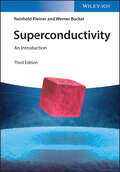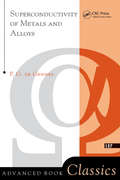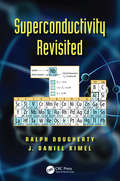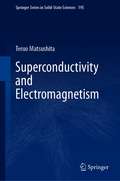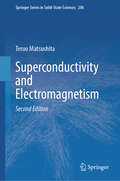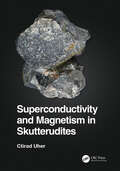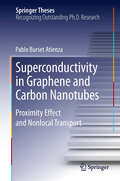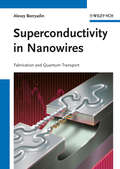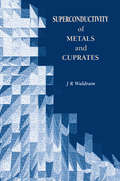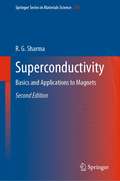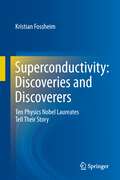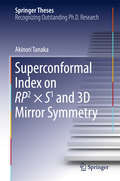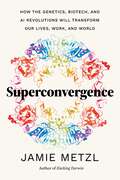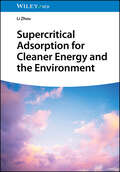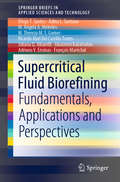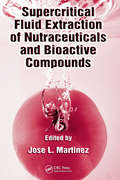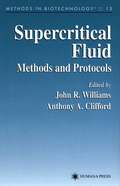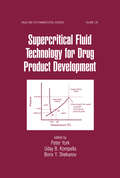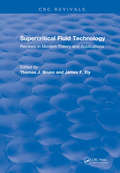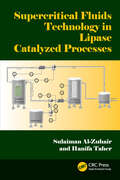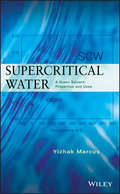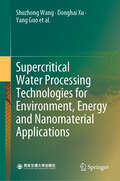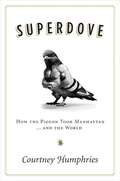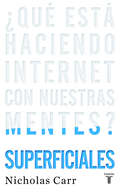- Table View
- List View
Superconductivity
by Reinhold Kleiner Rudolf Huebener W. BuckelThe third edition of this proven text has been developed further in both scope and scale to reflect the potential for superconductivity in power engineering to increase efficiency in electricity transmission or engines. The landmark reference remains a comprehensive introduction to the field, covering every aspect from fundamentals to applications, and presenting the latest developments in organic superconductors, superconducting interfaces, quantum coherence, and applications in medicine and industry. Due to its precise language and numerous explanatory illustrations, it is suitable as an introductory textbook, with the level rising smoothly from chapter to chapter, such that readers can build on their newly acquired knowledge. The authors cover basic properties of superconductors and discuss stability and different material groups with reference to the latest and most promising applications, devoting the last third of the book to applications in power engineering, medicine, and low temperature physics. An extensive list of more than 350 references provides an overview of the most important publications on the topic. A unique and essential guide for students in physics and engineering, as well as a reference for more advanced researchers and young professionals.
Superconductivity Of Metals And Alloys (Advanced Books Classics Ser.)
by P. G. De GennesDrawn from the author's introductory course at the University of Orsay, Superconductivity of Metals and Alloys is intended to explain the basic knowledge of superconductivity for both experimentalists and theoreticians. These notes begin with an elementary discussion of magnetic properties of Type I and Type II superconductors. The microscopic theory is then built up in the Bogolubov language of self-consistent fields. This text provides the classic, fundamental basis for any work in the field of superconductivity.
Superconductivity Revisited
by Ralph Dougherty J. Daniel KimelWhile the macroscopic phenomenon of superconductivity is well known and in practical use worldwide, the current theoretical paradigm for superconductivity suffers from a number of limitations. For example, there is no currently accepted theoretical explanation for the pattern of superconductor critical temperatures in the periodic table. Historical
Superconductivity and Electromagnetism (Springer Series in Solid-State Sciences #195)
by Teruo MatsushitaThis book introduces readers to the characteristic features of electromagnetic phenomena in superconductivity. It first demonstrates not only that the diamagnetism in the superconductivity complies with Maxwell’s theory, which was formulated before the discovery of superconductivity, but also that the dominant E-B analogy in the electromagnetism loses perfection without the superconductivity. The book then explores flux pinning, which is responsible for the non-dissipative current in DC, leading to irreversibility in AC. Drawing on Maxwell’s work, it also proves theoretically that if there is no energy dissipation in the superconductivity caused by the break in time reversal symmetry, it contradicts the thermodynamic principle of energy conservation – something that had previously only been proved experimentally.Lastly, the book addresses the longitudinal magnetic field effect, and explains how this phenomenon leads to a new development of Maxwell’s theory. Featuring numerous appendices to help readers understand the methods of derivation of equations, this book offers students and young scientists an introduction to applied superconductivity, especially in the context of power applications. Presenting the characteristic features of electromagnetic phenomena in superconductivity from basic to advanced topics for applications, the book offers a valuable resource for graduate students and researchers studying superconductivity as well as engineers working in electric utility industry.
Superconductivity and Electromagnetism (Springer Series in Solid-State Sciences #206)
by Teruo MatsushitaThis end edition introduces to the characteristic features of electromagnetic phenomena in superconductors, demonstrating how these phenomena not only align with Maxwell&’s theory but also expand its scope. By presenting examples of peculiar magnetic behaviors, the book broadens the reader&’s understanding of electromagnetism and its implications in superconductivity. The book explores key concepts such as flux pinning, responsible for non-dissipative currents in DC systems and hysteretic irreversibility in AC systems. This irreversibility, akin to friction, arises from the instability in the motion of quantized magnetic flux lines. Additionally, the longitudinal magnetic field effect is examined, highlighting its role in advancing Maxwell&’s theory. Through these discussions, readers will gain insights into the dynamics of quantized magnetic flux lines and the critical current density, crucial for the practical application of superconductors. With numerous appendices to support the derivation of complex equations, this book is an essential resource for students and young scientists interested in applied superconductivity, particularly in power applications. It offers a comprehensive introduction to the electromagnetic phenomena in superconductors, from fundamental principles to advanced topics. Graduate students, researchers, and engineers in the electric utility industry will find this book invaluable for its detailed exploration of superconductivity and its applications. Researchers and practitioners in the field of superconductivity, as well as engineers working in the electric utility industry, will benefit from the insights provided in this book. It serves as a critical resource for understanding the electromagnetic phenomena in superconductors and their practical applications, making it a must-read for those seeking to deepen their knowledge in this area.
Superconductivity and Magnetism in Skutterudites
by Ctirad UherSuperconductivity and Magnetism in Skutterudites discusses superconducting and magnetic properties of a class of materials called skutterudites. With a brief introduction of the fundamental structural features of skutterudites, the book then provides a detailed assessment of the superconducting and magnetic properties, focusing particularly on the rare earth-filled skutterudites where a plethora of fascinating properties and ground states is realized due to interactions of the filler species with the framework ions. Such interactions underpin the exciting forms of superconductivity and magnetism, most notably realized in the exotic heavy fermion superconductor of composition PrOs4Sb12. The two main topics of superconductivity and magnetism are provided with a concise introduction of superconducting and magnetic properties so that a reader can appreciate and understand the main arguments in the text. This book would appeal to graduate students, postdoctoral students, and anyone interested in superconducting and magnetic properties of a large family of minerals called skutterudites. Key Features:• Gives a thorough account of the superconducting and magnetic properties of skutterudites. • Each topic is accompanied by introductory sections to assist in the understanding of the text. • Supported by numerous figures and all key references.
Superconductivity in Graphene and Carbon Nanotubes
by Pablo Burset AtienzaThe unique electronic band structure of graphene gives rise to remarkable properties when in contact with a superconducting electrode. In this thesis two main aspects of these junctions are analyzed: the induced superconducting proximity effect and the non-local transport properties in multi-terminal devices. For this purpose specific models are developed and studied using Green function techniques, which allow us to take into account the detailed microscopic structure of the graphene-superconductor interface. It is shown that these junctions are characterized by the appearance of bound states at subgap energies which are localized at the interface region. Furthermore it is shown that graphene-supercondutor-graphene junctions can be used to favor the splitting of Cooper pairs for the generation of non-locally entangled electron pairs. Finally, using similar techniques the thesis analyzes the transport properties of carbon nanotube devices coupled with superconducting electrodes and in graphene superlattices.
Superconductivity in Nanowires: Fabrication and Quantum Transport
by Alexey BezryadinThe importance and actuality of nanotechnology is unabated and will be for years to come. <P><P>A main challenge is to understand the various properties of certain nanostructures, and how to generate structures with specific properties for use in actual applications in Electrical Engineering and Medicine.One of the most important structures are nanowires, in particular superconducting ones. They are highly promising for future electronics, transporting current without resistance and at scales of a few nanometers. To fabricate wires to certain defined standards however, is a major challenge, and so is the investigation and understanding of these properties in the first place. A promising approach is to use carbon nanotubes as well as DNA structures as templates.Many fundamental theoretical questions are still unanswered, e.g. related to the role of quantum fluctuations. This work is tackling them and provides a detailed analysis of the transport properties of such ultrathin wires. It presents an account of theoretical models, charge transport experiments, and also conveys the latest experimental findings regarding fabrication, measurements, and theoretical analysis. In particular, it is the only available resource for the approach of using DNA and carbon nanotubes for nanowire fabrication.It is intended for graduate students and young researchers interested in nanoscale superconductivity. The readers are assumed to have knowledge of the basics of quantum mechanics and superconductivity.
Superconductivity of Metals and Cuprates
by J.R WaldramSuperconductivity of Metals and Cuprates covers the basic physics of superconductivity, both the theoretical and experimental aspects. The book concentrates on important facts and ideas, including Ginzburg-Landau equations, boundary energy, Green's function methods, and spectroscopy. Avoiding lengthy or difficult presentations of theory, it is written in a clear and lucid style with many useful, informative diagrams. The book is designed to be accessible to senior undergraduate students, making it a helpful tool for teaching superconductivity as well as serving as an introduction to those entering the field.
Superconductivity: Basics and Applications to Magnets (Springer Series in Materials Science #214)
by R.G. SharmaThis book presents the basics of superconductivity and applications of superconducting magnets. It explains the phenomenon of superconductivity, describes theories of superconductivity, and discusses type II and high-temperature cuprate superconductors. The main focus of the book is the application of superconducting magnets in accelerators, fusion reactors and other advanced applications such as nuclear magnetic resonance (NMR), magnetic resonance imaging (MRI), high-gradient magnetic separation (HGMS), and superconducting magnetic energy storage (SMES). This new and significantly extended second edition covers the state of the art in the development of novel superconductors for advanced magnet applications, as well as the production of practical superconducting wires, tapes, and ultra high current cables used for high-field magnets. It includes two new chapters each devoted to MgB2 and Fe-based superconductors, and discusses the recently developed and world record-setting 45.5-Tesla magnetic field generated by a combination of conventional and high-temperature cuprate superconducting magnets. In addition, it discusses the status and outlook of all current and future nuclear fusion reactors worldwide. The chapter on accelerators includes the ongoing efforts to build high luminosity LHC (HL-LHC), the high-energy 28 TeV LHC (HE-LHC), the future circular collider (FCC) at CERN, and the just launched electro-ion collider (EIC) at Brookhaven National Laboratory. The book is based on the long-standing experience of the author in studying superconducting materials, building magnets and delivering numerous lectures to research scholars and students. The book provides comprehensive and fundamental knowledge in the field of applied superconductivity, greatly benefiting researchers and graduate students wishing to learn more about the various aspects of superconductivity and advanced magnet applications.
Superconductivity: Discoveries and Discoverers
by Kristian FossheimThis book is about the work of 10 great scientists; who they were and are, their personal background and how they achieved their outstanding results and took their prominent place in science history. We follow one of physics and science history's most enigmatic phenomena, superconductivity, through 100 years, from its discovery in 1911 to the present, not as a history book in the usual sense, but through close ups of the leading characters and their role in that story, the Nobel laureates, who were still among us in the years 2001-2004 when the main round of interviews was carried out. Since then two of them already passed away. For each one of the 10 laureates, the author tells their story by direct quotation from interviews in their own words. Each chapter treats one laureate. The author first gives a brief account of the laureates' scientific background and main contribution. Then each laureate tells his own story in his own words. This book is unique in its approach to science history.
Superconformal Index on RP2 × S1 and 3D Mirror Symmetry
by Akinori TanakaThe author introduces the supersymmetric localization technique, a new approach for computing path integrals in quantum field theory on curved space (time) defined with interacting Lagrangian. The author focuses on a particular quantity called the superconformal index (SCI), which is defined by considering the theories on the product space of two spheres and circles, in order to clarify the validity of so-called three-dimensional mirror symmetry, one of the famous duality proposals. In addition to a review of known results, the author presents a new definition of SCI by considering theories on the product space of real-projective space and circles. In this book, he explains the concept of SCI from the point of view of quantum mechanics and gives localization computations by reducing field theoretical computations to many-body quantum mechanics. He applies his new results of SCI with real-projective space to test three-dimensional mirror symmetry, one of the dualities of quantum field theory. Real-projective space is known to be an unorientable surface like the Mobius strip, and there are many exotic effects resulting from Z2 holonomy of the surface. Thanks to these exotic structures, his results provide completely new evidence of three-dimensional mirror symmetry. The equivalence expected from three-dimensional mirror symmetry is transformed into a conjectural non-trivial mathematical identity through the new SCI, and he performs the proof of the identity using a q-binomial formula.
Superconvergence: How the Genetics, Biotech, and AI Revolutions Will Transform our Lives, Work, and World
by Jamie Metzl"Superconvergence is brilliant. I can't recommend it more strongly."―Sanjay Gupta MD, bestselling author, neurosurgeon, and Emmy-award winning chief medical correspondent (CNN) In Superconvergence, leading futurist and OneShared.World founder Jamie Metzl explores how artificial intelligence, genome sequencing, gene editing, and other revolutionary technologies are transforming our lives, world, and future. These accelerating and increasingly interconnected technologies have the potential to improve our health, feed billions of people, supercharge our economies, store essential information for millions of years, and save our planet, but they can also―if we are not careful―do immeasurable harm. The challenge we face is that while our ability to engineer the world around us is advancing exponentially, our processes for understanding the scope, scale, and implications of these changes, and for managing our godlike powers wisely, are only inching forward glacially. Luckily, in Jamie Metzl, we have a leading expert who integrates science, technology, history, politics, and international affairs to envision a future that most specialists, almost by definition, cannot see. In this bold and inspiring exploration of transformative human knowledge, Metzl gives us the definitive account of the technological precipice on which we stand and the map to where we go from here.
Supercritical Adsorption for Cleaner Energy and the Environment
by Li ZhouComprehensive and technically detailed approach to addressing environmental and energy challenges through the advance of adsorption theory and techniques Supercritical Adsorption for Cleaner Energy and the Environment delves into the novel theory of supercritical adsorption and its practical applications in energy and environmental management issues. The book addresses critical topics such as supercritical adsorption and sustainable energy solutions, provides a deep understanding of advanced theories and techniques of supercritical adsorption, and addresses innovative methods for fuel desulfurization, natural gas storage, hydrogen energy, and emission-free coal power generation in the energy industry. The book is divided into two parts. The first part provides a comprehensive theory of supercritical adsorption, illustrated with examples that showcase significant progress in both applied and theoretical research due to recent advancements. Building on this theoretical foundation, the second part demonstrates how supercritical adsorption theory can address research questions in the fields of energy and environmental science. Supercritical Adsorption for Cleaner Energy and the Environment includes information on: Solutions for theoretical problems of supercritical adsorption, such as determination of absolute adsorption and the volume or density of the adsorbed phase Adsorptive technology to enhance natural gas storage, and methane enrichment from low-quality gas Ideas, chemical reactions, and materials and adsorbents used in supercritical adsorption research with the potential to transform approaches in environmental challenges Efficient and feasible strategies for achieving carbon circulation within the energy consumption and generation cycle Supercritical Adsorption for Cleaner Energy and the Environment is an essential forward-thinking reference for practitioners and researchers in the fields of chemistry, chemical engineering, energy, and environmental science.
Supercritical Antisolvent Precipitation Process: Fundamentals, Applications and Perspectives (SpringerBriefs in Applied Sciences and Technology)
by Diego T. Santos Ádina L. Santana M. Angela Meireles Ademir José Petenate Eric Keven Silva Juliana Q. Albarelli Júlio C. Johner M.Thereza M. S. Gomes Ricardo Abel Torres Tahmasb HatamiThis book provides deep insights on the fundamentals, applications and perspectives of the Supercritical AntiSolvent (SAS) Precipitation Process. Chapter 1 provides recent (2013-2018) reports on the use of supercritical CO2 (SC-CO2) antisolvent for micronization, coprecipitation and fractionation of high-value products for the food, cosmetic and pharmaceutical industries. Chapter 2 discusses another variant of the SAS precipitation process called Supercritical fluid extraction of emulsions (SFEE). This chapter provides recent data from 2016-2018 reports investigation of supercritical extraction of emulsions (SFEE) to encapsulate compounds of great interest to the food and non-food industry. Chapter 3 details the design and construction of a SAS Precipitation equipment. Chapter 4 presents experimental results regarding the validation of the supercritical particle formation equipment. Chapter 5 shows the effects of process parameters during particle precipitation using Combined High Turbulence Extraction Assisted by Ultrasound and Supercritical Antisolvent Fractionation (SAF) processes applied to semi-defatted annatto seeds, as a model raw material plant, were investigated. Chapter 6 shows experimental results regarding the process Ultrasound Emulsification Assisted by Nitrogen Hydrostatic Pressure (UEANHP), during the emulsification preparation step of the Supercritical Fluid Extraction of Emulsions (SFEE) process, one of the options of the SAS Precipitation-based process. Finally, Chaptesr 7 and 8 present some perspectives about the economics and process integration with other processes aiming the development of novel conceptual biorefinering approaches for plant materials valorization.
Supercritical Fluid Biorefining: Fundamentals, Applications and Perspectives (SpringerBriefs in Applied Sciences and Technology)
by Diego T. Santos Ádina L. Santana M. Angela Meireles Juliana Q. Albarelli Ricardo Abel Torres M. Thereza Gomes Aikaterini Bakatselou Adriano V. Ensinas François MaréchalThis book provides deep insights about the fundamentals, applications and perspectives of the use of supercritical CO2 as solvent and antisolvent for biorefinering.
Supercritical Fluid Extraction of Nutraceuticals and Bioactive Compounds
by Jose L. MartínezEnhanced concern for the quality and safety of food products, increased preference for natural products, and stricter regulations on the residual level of solvents, all contribute to the growing use of supercritical fluid technology as a primary alternative for the extraction, fractionation, and isolation of active ingredients. As a solvent-free p
Supercritical Fluid Methods and Protocols
by Anthony A. Clifford John R. WilliamsExperienced practitioners present detailed accounts of a wide variety of techniques using supercritical fluids. These range from the supercritical fluid extraction methods for numerous compounds to the ninhydrin staining of fingerprints on checks and banknotes-and from the detection of impurities in pharmaceuticals to a wide variety of applications throughout environmental and food science, and across analytical, clinical, and medicinal chemistry. Detailed step-by-step instructions enable users to apply these essential techniques successfully the first time and include modifications that permit their effective adaptation to novel experimental or process conditions. Versatile and comprehensive, Supercritical Fluid Methods and Protocols offers both novice and experienced investigators and laboratory analysts powerful tools that enable successful biological and bioprocess analyses and optimization today.
Supercritical Fluid Technology for Drug Product Development
by Uday B. Kompella Peter York Boris Y. ShekunovInterconnecting the fundamentals of supercritical fluid (SCF) technologies, their current and anticipated utility in drug delivery, and process engineering advances from related methodological domains and pharmaceutical applications, this volume unlocks the potential of supercritical fluids to further the development of improved pharmaceutical prod
Supercritical Fluid Technology: Reviews in Modern Theory and Applications (CRC Press Revivals)
by Thomas J. Bruno James F. ElyIn this volume, we have collected a series of reviews that cover both experimental and theoretical work geared toward the more exact requirements of current SFE applications. While we have artificially divided the volume into experimental and theoretical sections, natural overlaps will be apparent. Many of the papers on experimental and theoretical sections, natural overlaps will be apparent. Many of the papers on experimental technique contain discussions on equation of state correlations. Indeed, a good deal of the experimental work is intimately tied to a mathematical description of fluid mixtures. The theoretical section presents reviews that cover the modern theory of critical phenomena, methods to correlate near critical experimental results and approaches to understanding the behavior of near critical fluids from microscopic theory. It is hoped that the scope of these reviews will provide the reader with the basis to further develop our understanding of the behavior of supercritical fluids.
Supercritical Fluids Technology in Lipase Catalyzed Processes
by Sulaiman Al-Zuhair Hanifa TaherEnzymes are currently used in various industries, most commonly in food, detergents, and pharmaceuticals production. Lipases are hydrolytic enzymes that demonstrate great potential as an alternative to conventional catalysts in a number of industrial applications. A complete understanding of enzymes, and their proteins structure and environmental behavior, can greatly aid in the further development of industrial applications. Supercritical Fluids Technology in Lipase Catalized Processes provides basic information about enzymes, their sources, reaction kinetics, and main industrial applications. The book focuses in lipases. their main sources, structure, and features, with an emphasis on their specificity and interfacial activity, and presents proven techniques for isolating, extracting, and purifying. Comprised of six compact chapters, this comprehensive guide introduces: Immobilization techniques and immobilized lipases that allow repeated use (which is essential from an economic point of view) Different bioreactor configurations using immobilized lipases The latest information on the available technologies in lipolytic reactions The advantages of nonaqueous media in biochemical synthesis over aqueous and solvent-free systems Material on the use of lipases in nonaqueous media to overcome the drawbacks usually encountered with the use of conventional chemical catalysts The use of supercritical fluids (SCFs) as a green alternative reaction medium Factors affecting the physical properties of lipases in this medium and, hence, their activity and stability A case study using supercritical carbon dioxide (SC-CO2) for biodiesel production Novel, cutting-edge technology, using immobilized enzymes to reduce the overall production cost Supercritical Fluids Technology in Lipase Catalized Processes outlines the main industrial applications of common enzymes and discusses relevant challenges and innovations emerging in the field.
Supercritical Water
by Yizhak MarcusDiscover the many new and emerging applications of supercritical water as a green solventDrawing from thousands of original research articles, this book reviews and summarizes what is currently known about the properties and uses of supercritical water. In particular, it focuses on new and emerging applications of supercritical water as a green solvent, including the catalytic conversion of biomass into fuels and the oxidation of hazardous materials.Supercritical Water begins with an introduction that defines supercritical fluids in general. It then defines supercritical water in particular, using the saturation curve to illustrate its relationship to regular water. Following this introduction, the book: Describes the bulk macroscopic properties of supercritical water, using equations of state to explain temperature-pressure-density relationships Examines supercritical water's molecular properties, setting forth the latest experimental data as well as computer simulations that shed new light on structure and dynamics Explores the solubilities of gases, organic substances, salts, and ions in supercritical water in terms of the relevant phase equilibria Sets forth the practical uses of supercritical water at both small scales and full industrial scalesThroughout the book, the author uses tables for at-a-glance reviews of key information. Summaries at the end of each chapter reinforce core principles, and references to original research and reviews serve as a gateway and guide to the extensive literature in the field.Supercritical Water is written for students and professionals in physical chemistry, chemistry of water, chemical engineering, and organic chemistry, interested in exploring the applications and properties of supercritical water.
Supercritical Water Processing Technologies for Environment, Energy and Nanomaterial Applications
by Jie Zhang Shuzhong Wang Donghai Xu Yang Guo Xingying Tang Yuzhen Wang Honghe Ma Lili Qian Yanhui LiThis book systematically presents the technical aspects of supercritical water oxidation and supercritical water gasification for energy and environmental applications, which include reactor design, construction materials, corrosion, salt precipitation, etc. The book provides a comprehensive introduction to the properties of supercritical water, and the industrial applications, reaction mechanisms and reaction kinetics of supercritical water oxidation (SCWO) and supercritical water gasification (SCWG). The reactions occurring in supercritical water are complex, and studying their reaction mechanisms is of great importance for the development of supercritical water processing technologies. Accordingly, the book explains the oxidative mechanisms and kinetics of organic matter in supercritical water in detail. However, the harsh reaction conditions in supercritical water can easily create severe reactor corrosion and salt deposition problems. Therefore, the book also comprehensively reports on the mechanism analysis, state of research, and development trends regarding these two problems. Lastly, the book summarizes the development of supercritical water processing technologies, including studies on SCWO and SCWG, as well as near-zero-emission systems of pollutants based on SCWO technology. In short, the book provides a wealth of valuable information for all readers who are interested in using SCWO for organic waste treatment, and in using SCWG for hydrogen production with wet biomass.
Superdove: How the Pigeon Took Manhattan ... And the World
by Courtney HumphriesWhy do we see pigeons as lowly urban pests and how did they become such common city dwellers? Courtney Humphries traces the natural history of the pigeon, recounting how these shy birds that once made their homes on the sparse cliffs of sea coasts came to dominate our urban public spaces. While detailing this evolution, Humphries introduces us to synanthropy: The concept that animals can become dependent on humans without ceasing to be wild; they can adapt to the cityscape as if it were a field or a forest.Superdove simultaneously explores the pigeon's cultural transformation, from its life in the dovecotes of ancient Egypt to its service in the trenches of World War I, to its feats within the pigeon-racing societies of today. While the dove is traditionally recognized as a symbol of peace, the pigeon has long inspired a different sort of fetishistic devotion from breeders, eaters, and artists—and from those who recognized and exploited the pigeon's astounding abilities. Because of their fecundity, pigeons were symbols of fertility associated with Aphrodite, while their keen ability to find their way home made them ideal messengers and even pilots. Their usefulness largely forgotten, today's pigeons have become as ubiquitous and reviled as rats. But Superdove reveals something more surprising: By using pigeons for our own purposes, we humans have changed their evolution. And in doing so, we have helped make pigeons the ideal city dwellers they are today. In the tradition of Rats, the book that made its namesake rodents famous, Superdove is the fascinating story of the pigeon's journey from the wild to the city—the home they'll never leave.
Superficiales: ¿Qué está haciendo Internet con nuestras mentes?
by Nicholas Carr¿Qué está haciendo Internet con nuestras mentes? Este libro cambiará para siempre nuestro modo de entender y aprovechar las nuevas tecnologías. «¿Google nos vuelve estúpidos?» Nicholas Carr condensó así, en el título de un célebre artículo, uno de los debates más importantes de nuestro tiempo: mientras disfrutamos de las bondades de la Red, ¿estamos sacrificando nuestra capacidad para leer y pensar con profundidad? En este libro, Carr desarrolla sus argumentos para crear el más revelador análisis de las consecuencias intelectuales y culturales de Internet publicado hasta la fecha. Nuestro cerebro, como demuestran las evidencias científicas e históricas, cambia en respuesta a nuestras experiencias, y la tecnología que usamos para encontrar, almacenar y compartir información puede, literalmente, alterar nuestros procesos neuronales. Además, cada tecnología de la información conlleva una ética intelectual. Así como el libro impreso servía para centrar nuestra atención, fomentando el pensamiento profundo y creativo, Internet fomenta el picoteo rápido y distraído de pequeños fragmentos de información de muchas fuentes. Su ética es una ética industrial, de la velocidad y la eficiencia. La Red nos está reconfigurando a su propia imagen, volviéndonos más hábiles para manejar y ojear superficialmente la información pero menos capaces de concentración, contemplación y reflexión. Este libro cambiará para siempre nuestro modo de entender y aprovechar las nuevas tecnologías. Reseñas:«Absorbente y perturbador. Todos bromeamos sobre cómo Internet nos está convirtiendo, y especialmente a nuestros hijos, en cabezas de chorlito acelerados incapaces de meditaciones profundas. No es ninguna broma, insiste Carr, y a mí me ha convencido.»John Horgan, The Wall Street Journal «Una réplica calmada y elocuente a aquellos que afirman que la cultura digital es inofensiva, que afirman, de hecho, que nos estamos volviendo más listos cada minuto que pasa simplemente porque podemos conectarnos a un ordenador y dejarnos llevar por un interminable carrusel de links.»Julia Keller, Chicago Tribune
